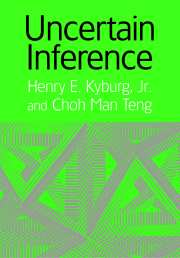Book contents
- Frontmatter
- Contents
- Preface
- 1 Historical Background
- 2 First Order Logic
- 3 The Probability Calculus
- 4 Interpretations of Probability
- 5 Nonstandard Measures of Support
- 6 Nonmonotonic Reasoning
- 7 Theory Replacement
- 8 Statistical Inference
- 9 Evidential Probability
- 10 Semantics
- 11 Applications
- 12 Scientific Inference
- Names Index
- Index
8 - Statistical Inference
Published online by Cambridge University Press: 07 December 2009
- Frontmatter
- Contents
- Preface
- 1 Historical Background
- 2 First Order Logic
- 3 The Probability Calculus
- 4 Interpretations of Probability
- 5 Nonstandard Measures of Support
- 6 Nonmonotonic Reasoning
- 7 Theory Replacement
- 8 Statistical Inference
- 9 Evidential Probability
- 10 Semantics
- 11 Applications
- 12 Scientific Inference
- Names Index
- Index
Summary
Introduction
We consider a group of puppies, take what we know about that group as a premise, and infer, as a conclusion, something about the population of all puppies. Such an inference is clearly risky and invalid. It is nevertheless the sort of inference we must make and do make. Some such inferences are more cogent, more rational than others. Our business as logicians is to find standards that will sort them out.
Statistical inference includes inference from a sample to the population from which it comes. The population may be actual, as it is in public opinion polls, or hypothetical, as it is in testing an oddly weighted die (the population is then taken to be the hypothetical, population of possible tosses or possible sequences of tosses of the die). Statistical inference is a paradigm example of uncertain inference.
Statistical inference is also often taken to include the uncertain inference we make from a population to a sample, as when we infer from the fairness of a coin that roughly half of the next thousand coin tosses we make will yield heads–a conclusion that might be false. Note that this is not probabilistic inference: the inference from the same premises to the conclusion that the probability is high that roughly half of the next thousand tosses will yield heads is deductive and (given the premises) not uncertain at all.
The inference from a statistical premise about a population to a nonprobabilistic conclusion about part of that population is called direct inference. The inference from a premise about part of a population to the properties of the population as a whole is called inverse inference.
- Type
- Chapter
- Information
- Uncertain Inference , pp. 175 - 199Publisher: Cambridge University PressPrint publication year: 2001



